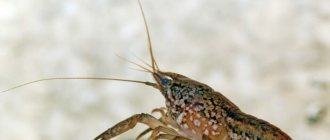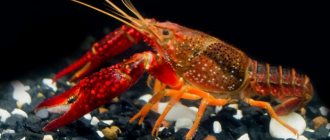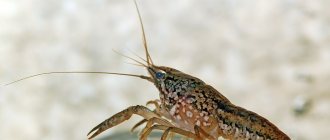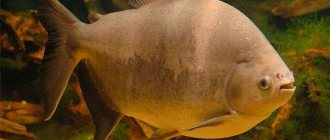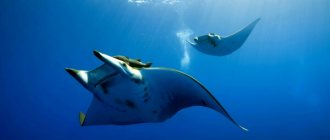author: fisher 06/05/2017 0 Comments
Freshwater crustaceans
invertebrates
Blue Cuban crayfish (Procambarus cubensis) is the first tropical crayfish that appeared among Russian aquarists back in 1980. As the name suggests, these crustaceans are native to the island of Cuba, where blue crayfish are quite common. Typical natural biotopes are small flowing reservoirs, including irrigation canals with clear and well-warmed water by the sun.
Not every aquarist knows that these entertaining crustaceans can not only live well in an aquarium, but also reproduce in it.
The body shape of the blue Cuban crayfish is not much different from its other relatives. By aquarium standards, this is a fairly large animal. The length of the body without claws can reach up to 15 cm, but is usually somewhat less.
Blue crayfish most of their time moving slowly along the bottom in search of food, with their claws pointed forward. For movement they use four pairs of legs located in the lower part of the cephalothorax. Long mustaches are used by crayfish as an organ of smell and touch.
Their abdomen consists of five segments, the last of which ends in a five-lobed caudal fin. On the inside of the abdomen there are swimming legs, or pleopods, which are in constant motion and serve the crayfish for swimming in the water column.
If necessary, a crayfish crawling along the bottom can with a sharp movement bend its segmented abdomen, ending with a fan-shaped fin, under itself and swim away in the opposite direction with quick pushes in reverse.
The claws of the blue Cuban crayfish have small spines that help the crayfish in nature defend itself from numerous enemies.
Blue Cuban crayfish
The color of young Cuban crayfish is not at all blue, but rather inconspicuous gray, more reminiscent of the color of our crayfish. Despite the name, the blue color of these crayfish is not specific. Depending on the conditions of detention, diet and heredity, it can vary greatly.
For example, you can find Cuban blue crayfish painted in all shades of blue, from light blue to rich ultramarine, and with a body color from the yellow-brown palette. Cuban blue crayfish fully colored only in the second year of life.
Keeping Cuban blue crayfish in an aquarium
In general, keeping blue crayfish in an aquarium is not difficult. It is enough to fill it with settled water with a hardness of at least 8-12dGH, since crustaceans need calcium to form a chitinous shell and maintain the temperature within 20-28°C.
The hydrogen index can be in a wide range of values from 4.8 to 7.6 units.
As for the volume of the aquarium, the following recommendation should be followed: for one adult blue crayfish there should be twenty liters of water. An air compressor is required. Daylight hours should be at least 10-12 hours. The air compressor can be replaced with an oxidizer (its brand is chosen depending on the volume of the aquarium). In addition to saturating water with oxygen, the device effectively oxidizes animal waste products, thereby improving water quality.
Crayfish are sensitive to the oxygen content in water, as well as the presence of ammonia, ammonium, nitrites and nitrates. The nitrate content in the water should not exceed 100 mg/l; this can be achieved by weekly replacing one-fourth of the aquarium volume.
In addition to changing the water, it is recommended to install a high-performance filter in the aquarium, preferably a canister filter. It is highly desirable to use a section with activated carbon and zeolite (which is replaced once a month).
In an aquarium with crayfish, there must be soil containing sand and small pebbles, since after molting the animals use grains of sand for the proper functioning of their balance organs (statocysts).
In the first segment of the crayfish antennae there is a depression in the form of a small internal pocket where special sensitive hairs are located, which are affected by grains of sand. When the cancer sheds its old shell during molting, it leaves behind grains of sand. Later, after changing into a new protective suit, the cancer places new grains of sand into the openings of the ear sacs. To this end, he immerses his head in the sand. After which the balance organ begins to work again.
At the bottom of the aquarium you should place a large number of different shelters: ceramic pots, pipes, stone grottoes, etc. So that during the molting period crayfish can feel completely safe. Plants can be used both live and artificial. If everything is clear with artificial ones, then as living ones you should choose rigid-leaved species through which crayfish could rise to the surface (Echinodorus, Anubias, some types of Cryptocorynes). Soft-leaved plants will be quickly destroyed. The ideal option for blue Cuban crayfish is a species aquarium.
Crayfish are able to get out of the aquarium. Usually the cause of escape is water spoilage or a decrease in the oxygen content in it. Most often this happens at night. To avoid this, you should not fill the aquarium to capacity with water; the water should be at least 4-5 cm from the top edge. Also, do not forget about the cover glass or lid.
Blue Cuban crayfish
When kept in optimal conditions, which means clean water with a minimum content of nitrates, plus a varied diet, in the second year of life, blue crayfish acquire an intense blue color.
In an aquarium, Cuban crayfish live up to three years.
Most often, beginners are interested in whether it is possible to keep blue crayfish together with fish in a common aquarium. The answer is not clear - it is possible, but not with everyone. Crayfish by their nature are not active predators; they are effective saprophages, the basis of their diet is decaying organic matter, both animal and plant origin. Unlike catfish, they are able to clean the aquarium not only from food residues, but also from dead animals and plants.
Blue Cuban crayfish fish specifically . And they are not able to harm large and fast fish.
Small fish (neons, guppies, etc.) can be subject to aggression from blue crayfish
Blue crayfish should not be kept with large predatory fish (arowanas, tetraodons, stingrays, etc.), since in this case the crayfish themselves can become their prey.
When introducing young crayfish into an aquarium, you often have to take care of their lives, and not vice versa. Juvenile crayfish are actively growing, which means frequent molting. Having lost their shell, they become practically defenseless for a short time. During this period, becoming an affordable delicacy for many fish and their fellow fish.
Description
The Florida blue crayfish, or, as it is popularly called, blue crayfish, is a freshwater crustacean belonging to the Cambaridae family. The habitat of blue crayfish is the USA, Florida. But if the natural color of crustaceans is blue, then the selective form of cancer is in great demand among aquarium owners. The Florida crayfish has a bright blue color.
Florida crayfish has a bright blue color
Now Florida crayfish are very popular among aquarists, so they are grown in many countries around the world. Russia and other countries of the post-Soviet space are no exception. Cancers are not picky, so they are easy to care for. This option is perfect for beginner aquarists who do not want to spend a lot of time and effort on raising an underwater pet. There is one condition. Crayfish cannot get along well with all fish, so it is advisable to purchase a separate aquarium .
Diet of Blue Cuban Crayfish
The diet of blue Cuban crayfish consists of ordinary live food: bloodworms, coretra, tubifex, earthworms, in the absence of which you can give them small pieces of meat, squid, beef liver, and lean sea fish. Vegetable foods include soft aquatic vegetation (duckweed, elodea, etc.), rolled oats washed under running tap water, boiled rice, and vegetable tablets for catfish. It is advisable to alternate feeds to ensure adequate nutrition.
Today, many well-known manufacturers produce special food for crustaceans containing everything necessary for their harmonious development.
Shedding
Blue crayfish, just like all others, shed their shells in due course, but young ones molt more often than adults. Molting occurs gradually:
- the shell bursts along the entire back;
- the individual crawls out from under the old skin and claws;
- the cover is similar to a living crayfish with claws and antennae, only the shell becomes transparent;
- cancer, which has become defenseless for a while, eats up its dropped defenses in 2-3 days;
- in 3 days a new hardened shell is formed.
The time when the animal is left without protection is the most dangerous for it - the Cuban is now an easy prey for its fellow fish, large carp or cichlid fish. Therefore, during the molting period, it is better to remove the crayfish and feed them well.
Blue Cuban crayfish - sexual dimorphism
Sexual dimorphism in blue Cuban crayfish is quite clearly expressed and begins to appear when they reach the age of 5-6 months. Males have more powerful and longer claws. By this time, two pairs of anterior swimming legs are fused, turning into a copulatory organ (gonopodium), pressed to the body and directed forward. In females these legs are very small or absent altogether.
In addition to external differences, males and females also differ in behavior. So the first ones are territorial and occupy some secluded place where they always return after feeding. Females do not have such a place; they roam throughout the aquarium. Therefore, when keeping two or more male blue Cuban crayfish in one aquarium, you should be prepared for periodic skirmishes, sometimes quite serious, which can even result in the loss of limbs.
Blue Cuban crayfish - female
Raising young crayfish
Raising young animals is not difficult. For small crustaceans, practically the same food as for adults is suitable: frozen cyclops, small daphnia, tubifex or bloodworms, which must first be finely chopped, blue whiting fillets, gammarus, food for fish fry. It is important to feed small Cubans with other small crustaceans (cyclops, etc.), this is necessary for the formation of the shell.
Blue Cuban crayfish, ready to detach themselves from their mother.
Small crustaceans molt frequently, almost every week, and upon reaching sexual maturity - every month. A pronounced blue color appears after molting, but the Cuban will acquire a bright and rich color only at two years. During molting, crayfish cannot eat, and they definitely need shelter, otherwise luckier relatives may devour their brothers and sisters . But, thanks to a change in shell, crustaceans can grow new antennae, legs, even eyes damaged in battle or during mating.
Animals usually eat the shed shell.
The water in the container with crayfish must be changed every day, draining and adding about a quarter. The water should not be chlorinated; to do this, it must be kept in a separate container without a lid (preferably a jug or can with a large neck).
Reproduction of blue Cuban crayfish
Having reached sexual maturity by 7-8 months (when kept in water with a temperature of 25-27°C), crayfish are able to reproduce, regardless of the time of year.
To do this, you need to prepare a separate container, without soil. A twenty-liter tank will be quite enough for one pair of producers.
The water temperature in the spawning tank should be maintained at 25°C. It is advisable to install several grottoes or other similar shelters at the bottom of the tank.
The air compressor must provide 24/7 aeration. To maintain nitrates at an acceptable level, once a week you should replace a quarter of the water with fresh water.
Separately kept males and females are planted in pairs. Mating usually doesn't take long to happen. The male flips the female onto her back and holds her with his claws throughout the entire mating process, which can take from several minutes to an hour and a half. After the process is completed, the male should be transferred to another aquarium.
Mating in blue crayfish does not yet mean fertilization of the egg; it will happen later, when the female begins to lay eggs, and this can happen either the next day or a month later. All this time, the seminal fluid is stored in the female’s ovipositor. Before laying eggs, with the help of special glands, the female produces a special adhesive substance with which the eggs are firmly attached to her abdominal legs.
During the gestation period, which can last from 25 to 30 days, the female does not lose activity. To create a flow of water, she is forced to constantly move her legs, enriching the clutch with oxygen, which can number from 30 to 300 eggs with a diameter of up to 2 mm. The laid eggs initially have a dark blue (almost black) color. After some time, fertilized eggs lighten and by the age of two weeks acquire a greenish tint. At this time, upon careful examination, you can notice the movement of the embryo inside the almost transparent shell.
In a spacious community aquarium with plenty of hiding places, spawning can occur spontaneously. The aquarist often learns about this event only after seeing eggs on the female. To prevent hatched crustaceans from being eaten by other inhabitants of the aquarium, the female with her future offspring should be transplanted into a separate container.
A female can lay eggs without mating with a male (for example, if there is no male, or has not reached sexual maturity). In this case, the caviar has a pale pink color. It is impossible to obtain offspring from unfertilized eggs. After some time, the female sheds such eggs without waiting for them to be infected with saprolegnia.
While bearing offspring, the female is fed every other day with live food (bloodworms or tubifex), preferably a little at a time. At three weeks of age, the embryos are painted pink, and the contours of their body are clearly visible through the egg shell.
While the eggs are on the female's body, she is well protected. So, when danger arises, for example when catching it, the female bends the caudal fin, pressing it tightly to the abdomen, thereby reliably covering the clutch.
But the juveniles that appear in the general aquarium are practically doomed. Not a single aquarium inhabitant will miss the opportunity to enjoy a delicacy in the form of newly hatched crustaceans.
Depending on the temperature, crustaceans appear on days 25-28. During the first two days, the juveniles move from the legs to the back of the female, presumably feeding on microparticles of her outer integument.
The crustaceans hang on the female for about another week, after which they move on to independent life. At this point, it is recommended to transplant them into a separate container at the rate of one liter of water per crustacean, or remove the female from the spawning tank. A third of the water volume in an aquarium with juveniles should be changed daily.
Newly added water must not contain chlorine! In most species of decapod crayfish, pelagic larvae emerge from the eggs. Depending on the species, they go through different larval stages. In blue crayfish, the entire metamorphosis takes place inside the egg and fully formed crustaceans are born, which are a very small (3-3.5 mm), with a transparent shell, copy of their parents.
If a culture of ciliates or live dust would be needed to feed the larvae, then the young crustaceans can immediately consume Artemia nauplii. Thanks to this, feeding them is not difficult.
You can raise crayfish using ready-made powdered food for fish fry, but this method is worse, since it is quite difficult to calculate the required amount of food, and uneaten food quickly leads to water spoilage. The more varied and nutritious the food, the more often young crustaceans molt.
Usually, after 10-12 days, at the bottom of the aquarium you can see many transparent shells that are very similar to the crustaceans themselves; they can easily be confused with a dead individual. This is actually the result of molting.
Young crustaceans grow quickly and therefore are forced to shed their old shell every 8-10 days, since, unlike cancer, it does not grow with it and soon becomes too small for it.
With age, the interval between molts increases. Watching the molting process is quite interesting. The old shell bursts on the back and the cancer crawls out of it. The discarded shell is sometimes eaten by other crayfish, and sometimes lies on the bottom for some time until it begins to disintegrate. Eating the shed shell by other crayfish indicates a lack of calcium in their body. To replenish their reserves, crayfish sometimes eat small shells, both empty and with mollusks.
Having shed its protective shell, the cancer becomes completely defenseless, at which point it can easily become prey not only for fish, but also for its fellow tribesmen. The limbs are the first to be affected. Fortunately, nature, unlike people, has given crayfish the ability to regenerate lost limbs, especially young individuals. Therefore, after some time they are completely restored.
After one and a half to two months, the juveniles should be sorted by size, since with age their regenerative abilities weaken, and larger individuals are capable of causing irreparable harm to their smaller counterparts.
Appearance and color
With the exception of their unusual color, blue crayfish are practically no different from classic crayfish. The cephalothorax, like that of ordinary crayfish, is covered with a protective shell, and the back of the body consists of segments and a caudal fin . Cancer has five pairs of walking legs, the first pair being claws. Antennae, antennae and eyes are all the sense organs of cancer. They are located on the head . There are several jaws at the bottom of the head.
What does a blue crayfish look like?
Males have a longer abdomen and wide claws. In addition, if you turn them over on their backs, you can see the gonopodium on the abdomen. This is a special copulatory organ used for fertilization . While males grow to 6-7 cm in length, females are usually several centimeters larger.
Note! The main feature of the blue crayfish is its unique color. Often the body is colored deep blue, but sometimes it can have a purple tint.
The main feature of the blue crayfish is its unique color
Diseases of Blue Cuban Crayfish
Crayfish often die from high nitrate content in water, so you need to monitor this indicator. The most common diseases of blue crayfish are as follows:
Crayfish plague is caused by the fungus Aphanomyces astaci. This disease has no cure.
Porcelain disease is caused by single-celled parasites (Thelohania contejani). Infection can occur from another cancer patient. This disease affects the muscles of the abdomen and limbs. The disease has no cure.
Burn disease. Appears as brown and black spots on the shell and limbs. It is treated with lotions made from fallen oak or alder leaves.
Parasites. They settle on the outer covers and gills of crayfish. These are very small (1-2 mm) leeches Branchiobdella sp. yellow-white color. You can get rid of them with 1.5% salt baths.
Keeping and breeding blue Cuban crayfish is possible not only for experienced, but also for novice aquarists. And their beauty, mobility and unpretentiousness will give you a lot of pleasant moments.
Where do they live?
You can see blue crayfish in their natural environment only in the United States (and only in their natural brown color). They live in small bodies of water, mostly standing (ponds, swamps or lakes). Crayfish often live in the muddy bottom, where they dig special passages for themselves. At the bottom they get food. The main diet of blue cancer is detritus .
Blue crayfish look very beautiful and unusual
Crayfish living in the wild lead a cautious lifestyle; at the slightest sign of danger, they run away or simply bury themselves in soft soil . But if we talk about aquarium crustaceans, their behavior is completely opposite. Such individuals almost always behave impudently and there can be no talk of any fears.
General recommendations
- Live arthropods should be kept cool, away from light and heat, until they are ready to cook
- Wash the crayfish. This process is also called crayfish cleaning. Place them in a large bucket and fill it with clean water. Use the tool to stir them for a few minutes. Rinse them and place them in another clean container. If you decide to buy crayfish in Rostov-on-Don from our company, you can skip this procedure - all individuals have undergone preliminary training.
- Don't let live crayfish sit in the water for too long.
- Some people add a box of salt to the water to cleanse the crayfish.
- Dead crayfish float to the top and should be discarded.
buy boiled crayfish from us and skip all these preliminary procedures.
